RESEARCH
for full collection of visual research, please refer to this pinterest page
After Laura Hopkins briefed us, I was kind of shocked to be honest. I had the vaguest memory of this major event especially since I grew up in the Middle East. I was 5 years old at the time the scandle was revealed, so the name rang a bell but this was the first time I had seen the photos.
The first step of research was to do a lot of reading. Some of the texts I read were:

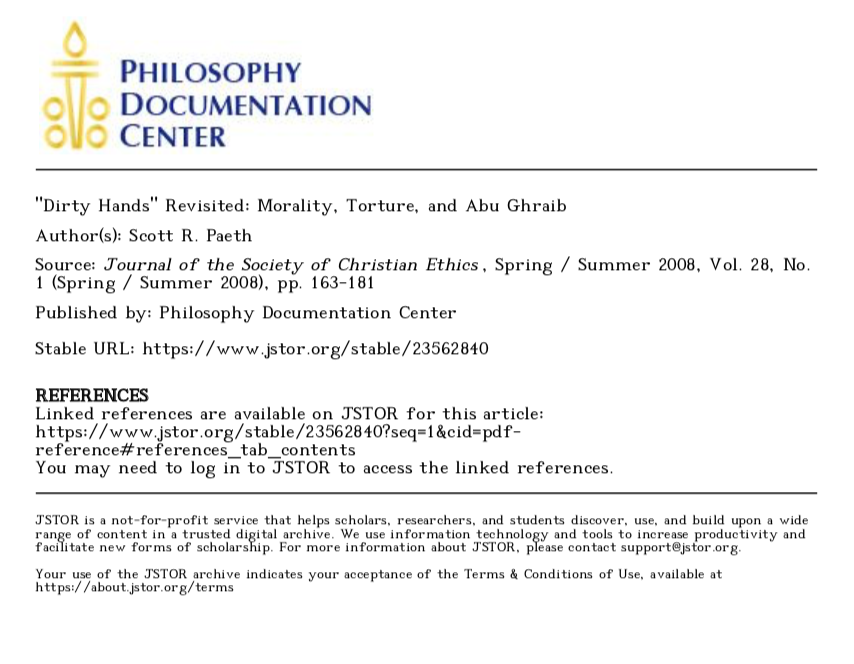

1. Mokhtari ,S. 2009, After Abu Ghraib Exploring Human Rights in America and the Middle East, Cambridge University Press, Cambrdige.
2. Paeth, S. R. 2008, “‘Dirty Hands’ Revsited: Morality, Torture, and Aby Ghraib”, Journal of the Society of Christian Ethics, vol. 28, no. 1, pp. 163-181.
3. Williams, C & Van der Merwe, J. 2013 “The Psychological Impact of Torture”, British Journal of Pain, vol. 7, no. 2, pp. 101-106.
![]()
In my discussions with Laura, we hashed out why I was most drawn to the image of “The Hooded Man” itself. Not only was it an incredible opportunity to be able to capture Al-Qaisi’s lived experience, but I also felt that it was the most feasible image for an audience to connect to. It is a watered down depiction of the horror.
In a way, compared to other images (which I have not included on this page due to sensitivity), it is the easiest to place ourselves within. Upon first glance, it is just a man in a blanket standing upright, not too horrific. Additionally, due to the image being mass circulated, we have become de-sensitized.But after reading Al-Qaisi’s testimonies it changes the perspective.
2. Paeth, S. R. 2008, “‘Dirty Hands’ Revsited: Morality, Torture, and Aby Ghraib”, Journal of the Society of Christian Ethics, vol. 28, no. 1, pp. 163-181.
3. Williams, C & Van der Merwe, J. 2013 “The Psychological Impact of Torture”, British Journal of Pain, vol. 7, no. 2, pp. 101-106.
The most significant text I came across was an interview with Ali Shallal Al-Qaisi, a victim of the Abu Ghraib torture. Most notably, he is the man in the infamous “cover image” for the scandle “The Hooded Man”.
This article from The New Arab in 2015 included Al-Qaisi’s reflections and memories of his detainment at the Abu Ghraib prison as well as his official testimonies that were used in the tribunals.
I picked out some quotes that stuck with me which became the basis of my visual research and sensory elements of my design. I began by looking at “The Hooded Man” photograph in detail, and coming across artistic interpretations, and even a second photograph from the prison.
![]()
This article from The New Arab in 2015 included Al-Qaisi’s reflections and memories of his detainment at the Abu Ghraib prison as well as his official testimonies that were used in the tribunals.
I picked out some quotes that stuck with me which became the basis of my visual research and sensory elements of my design. I began by looking at “The Hooded Man” photograph in detail, and coming across artistic interpretations, and even a second photograph from the prison.
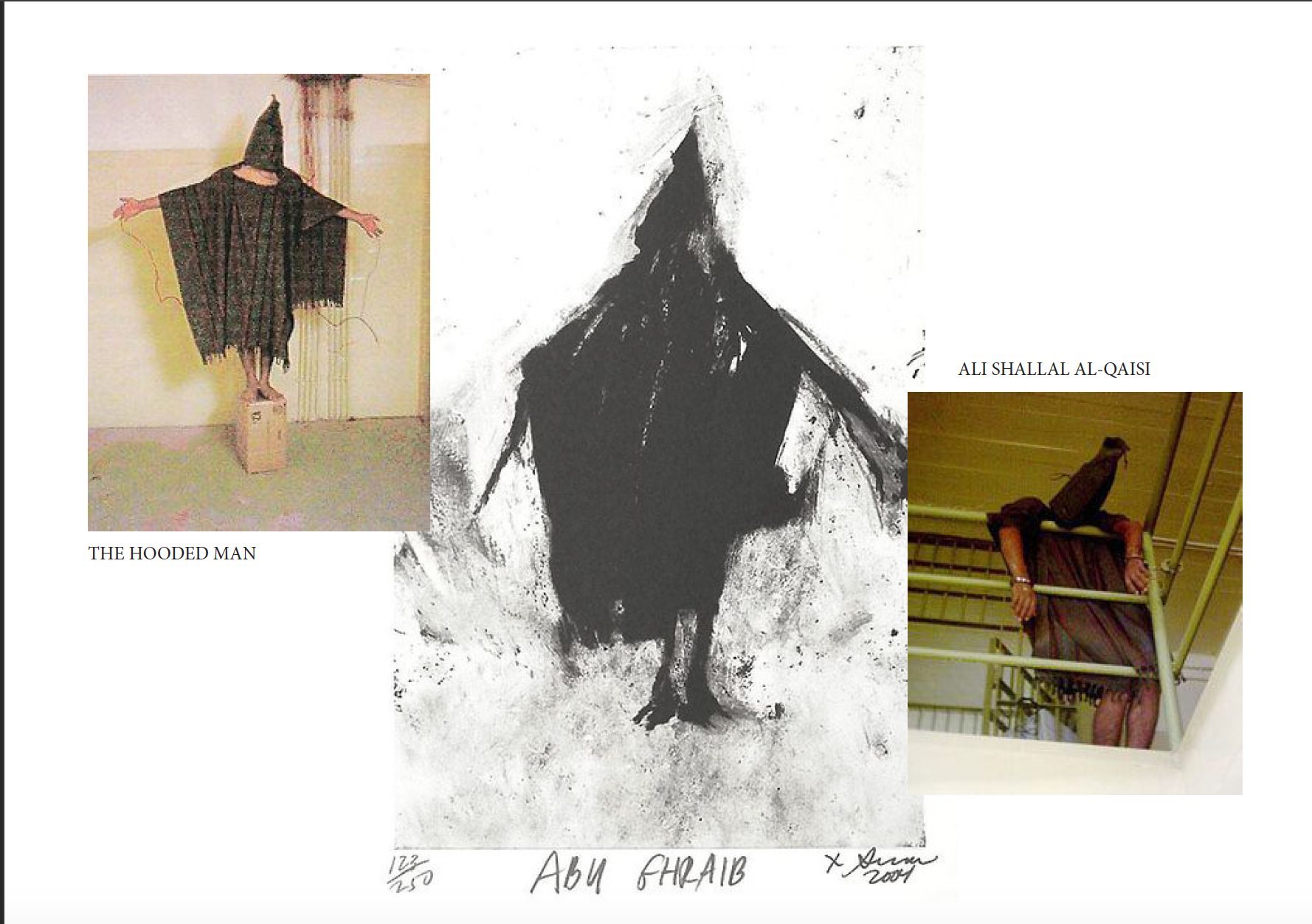

In my discussions with Laura, we hashed out why I was most drawn to the image of “The Hooded Man” itself. Not only was it an incredible opportunity to be able to capture Al-Qaisi’s lived experience, but I also felt that it was the most feasible image for an audience to connect to. It is a watered down depiction of the horror.
In a way, compared to other images (which I have not included on this page due to sensitivity), it is the easiest to place ourselves within. Upon first glance, it is just a man in a blanket standing upright, not too horrific. Additionally, due to the image being mass circulated, we have become de-sensitized.But after reading Al-Qaisi’s testimonies it changes the perspective.
I became focused on creating a sensory interpretation of Al-Qaisi’s experience from his capture leading up to him becoming this infamous image. I want to explore the deep psychological impacts of what the image represents specifically using Al-Qaisi’s memory of it. What are the details that remain haunting him. I want to use this as a deeper investigation of this photograph in order to evoke the story behind it to an audience who may be learning about Abu Ghraib for the first time, like myself when making this.

Firstly, I looked at the idea of existing within a cage of what the world wants to see you as. Igor Morski’s artworks are a structural compositional connection to how Al-Qaisi’s as a human was caged behind the image of “The Hooded Man”.
However, I felt like I was more interested in this idea through the lens of dehumanising the person rather than the “idealism” depicted in Morski’s art.
However, I felt like I was more interested in this idea through the lens of dehumanising the person rather than the “idealism” depicted in Morski’s art.
Secondly, I was interested in the sensory details from Al-Qaisi’s memory and looking at how trauma lingers within the body. I was particularly drawn to the use of black & white contrast in Laurence Demaison’s photography (left).
Also I was interested in the liminality of bodies that experienced trauma creating a lingering impact in a space, as seen in Pia Mannikko’s work (right).
Also I was interested in the liminality of bodies that experienced trauma creating a lingering impact in a space, as seen in Pia Mannikko’s work (right).

Thirdly, I looked at the presence of the body branching out from my research of Igor Morski’s work. I was interested in the existance of the body as a vague form of a human, but having all humanity and personality stripped away.
Notable works included: from left to right
Notable works included: from left to right
- Hussein Chalayan’s “Gravity Fatigue” at Sadlers Wells 2015
- Jacob Sutton’s photography
- Romeo Castelluci’s “Orestie”
- James Cullen’s photography
- Phillip Prokopiou‘s photography
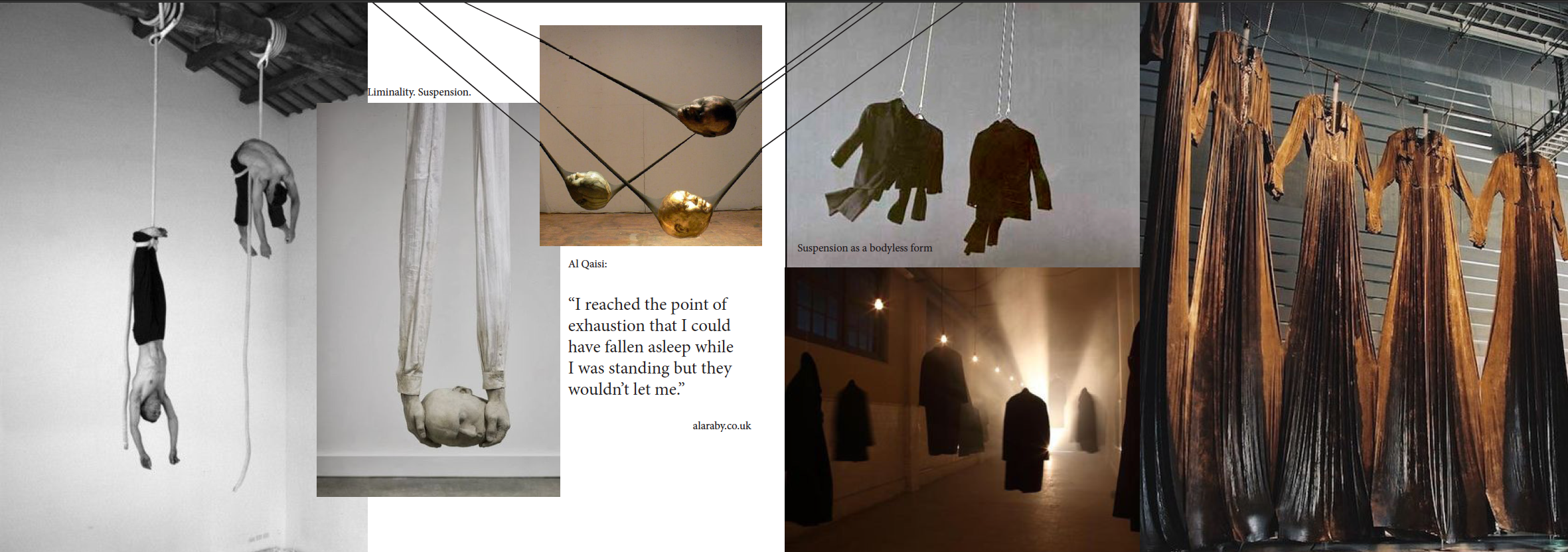
Next, I was interested in the feeling of suspension based off the above direct quote from Al-Qaisi. Combined with the previous research, I was exploring the concept of being a draped form forced into suspension causing fragility, weakness, but also a liminal presence.
Notable works included: from left to right
I also looked into the images to the right as a way of representing quantity: the sheer amount of people detained and tortured in the prison. Inspired by Al-Qaisi’s memory of being forced to strip of their clothes upon entering, I was inspired by these visuals of all personality getting left behind.
Notable works included: from left to right
- Peter D Brown’s photography
- Robert and Shana Parke Harrison’s sculptures
- Jurgen Klauke’s installations
- Boltanski’s installations in Buenos Aries 2012
- Chiharu Shioti’s installations
I also looked into the images to the right as a way of representing quantity: the sheer amount of people detained and tortured in the prison. Inspired by Al-Qaisi’s memory of being forced to strip of their clothes upon entering, I was inspired by these visuals of all personality getting left behind.
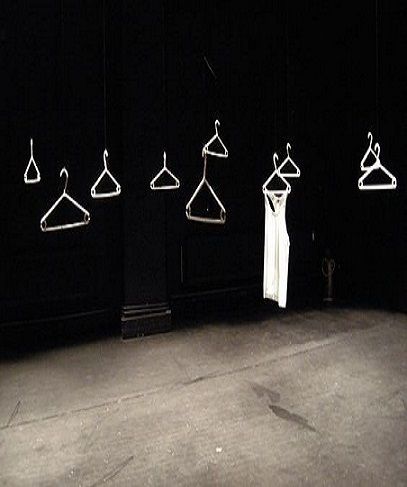
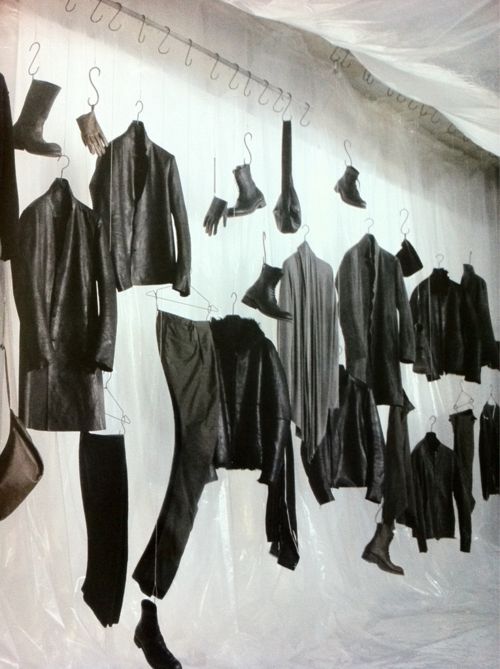

Lastly, I looked at material. I took note of the fact that Al-Qaisi mentioned it was December at the time of his detainment, which is cold, so I thought of metal.
I researched Jacob Burmood’s sculpture work because he is able to capture form, fragility, and lightness while using heavy and harsh bronze. This gave me the initial idea to create a bronze cast of the form of The Hooded Man as part of the installation.
I researched Jacob Burmood’s sculpture work because he is able to capture form, fragility, and lightness while using heavy and harsh bronze. This gave me the initial idea to create a bronze cast of the form of The Hooded Man as part of the installation.
NEXT: PROCESS ︎︎︎
© Jida Akil 2025